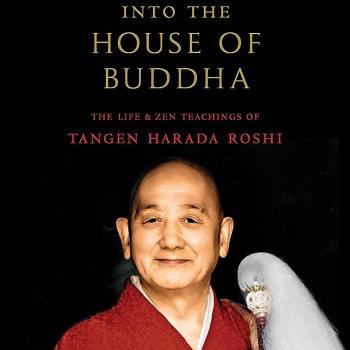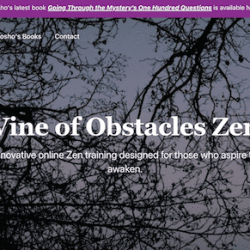 At the study group last night, we discussed a way of looking at practice that has three faces.
At the study group last night, we discussed a way of looking at practice that has three faces.
First is when practice is about seeking. Sometimes we manifest this by leaning forward in zazen, seeking kensho like a donkey chomping at the carrot dangling from the stick. This is often referred to (or justified) as the sudden approach and is associated with the Rinzai school (I don’t see this as fair or accurate but that’s not the point right now).
The second way of practice focuses on this moment’s experience, whatever that is – delusion, anger, bliss – as the enlightenment at hand. This is quite popular because of the connections apparent with Western psychology – the nonjudgemental acceptance of whatever is arising.
Sometimes we manifest this by (subtly or not so subtly) slouching, head tilted down and the heart caved in. This is my observation – no offense intended – please check it out and report your findings! This orientation in practice is often referred to as the gradual approach and is associated with the Soto school (again, I don’t see this as fair or accurate but that’s still not the point right now).
The third approach focuses on expression. In my view, this is a fair and accurate rendering of the heart of Dogen’s Zen – practicing enlightenment and is the point right now.
I quoted a short bit of Dogen in an earlier post that presents this clearly, although I admit that and it sounds pretty odd:
“[To] do sitting buddha and do making buddha, are called ‘bringing forth the mind of enlightenment.'”
The emphasis here is on doing, or expressing sitting buddha, expressing making a buddha and occurs in a chapter significantly rendered as “Bringing Forth the Mind of Bodhi.”
The Way Seeking Mind here is not a personal psychological experience but an activity, an activity that can occur in all the myriad forms of living this life. The seeking here is seeking to fittingly express Buddha now – not get a personal high but to really make an impact within this wandering in circles world.
This “third way” leaps clear of groping and slouching. If you take it up you might find that it shifts your practice in subtle (and maybe even dramatic) ways free from the dualism and false choice of attainment or nonattainment.
How can Buddha be expressed in this specific situation now?
The many detailed instructions in Soto Zen are intended to offer how a Buddha would do/express this – how would Buddha sit, walk, lie down, or wipe his/her butt, for instance.
These instructions are sometimes mistaken (and often mistakenly presented) as fetishism (i.e., magical thinking that if I wipe my butt correctly that I’ll be mysteriously enlightened).
And although how a Buddha behaves is culturally specific and so it makes little sense to import many of the specific practices (wiping the butt with a clay ball, for example), it does make sense to import at least the essential form – zazen, not as groping or slouching but as expressing Buddha.
Then we can delight in an open field of play in which we explore, for example, expressing “good morning” as Buddha (i.e., awake-one) to a sullen teenager.
How does this sit with you?











